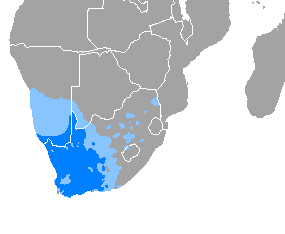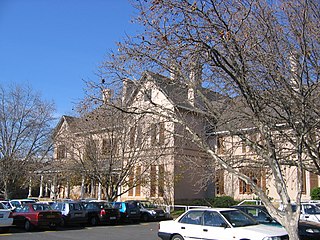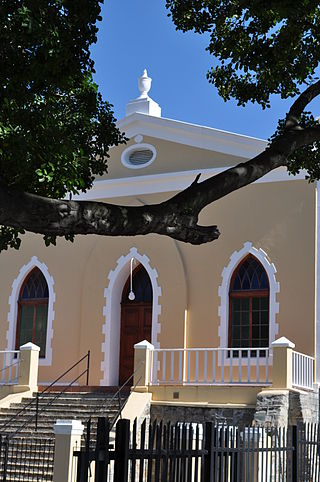This article needs additional citations for verification .(November 2019) |
The Alhambra Bioscope, also known as the Alhambra Theatre, was a theatre that opened on Riebeek Street, Cape Town, South Africa in 1929.
This article needs additional citations for verification .(November 2019) |
The Alhambra Bioscope, also known as the Alhambra Theatre, was a theatre that opened on Riebeek Street, Cape Town, South Africa in 1929.
The Alhambra was built in 1928 for Harry Stodel's African Consolidated Theatres. It was called South Africa's best "atmospheric theatre." [1] [2] It had a Wurlitzer theatre organ that could produce many sound effects. [3] It opened in 1929.
Plays and musicals were also presented for four decades in the theatre. Among the entertainers to perform here were Marlene Dietrich, [4] Nellie du Toit, [5] Angelo Gobbato, [6] and Phyllis Spira. [7]
The only Afrikaans language theater company to perform here, according to André Huguenet, was his company with its production of Is Jy ’n Bokryer? in the 1940s. [2] It was also sometimes used by KRUIK (the Cape Performing Arts Council).
The building closed in January 1972 and was sold in 1974 and demolished the same year.

Afrikaans is a West Germanic language, spoken in South Africa, Namibia and Botswana, Zambia and Zimbabwe. It evolved from the Dutch vernacular of South Holland spoken by the predominantly Dutch settlers and enslaved population of the Dutch Cape Colony, where it gradually began to develop distinguishing characteristics in the 17th and 18th centuries.

White South Africans are South Africans of European descent. In linguistic, cultural, and historical terms, they are generally divided into the Afrikaans-speaking descendants of the Dutch East India Company's original colonists, known as Afrikaners, and the Anglophone descendants of predominantly British colonists of South Africa. In 2016, 57.9% were native Afrikaans speakers, 40.2% were native English speakers, and 1.9% spoke another language as their mother tongue, such as Portuguese, Greek, or German. White South Africans are by far the largest population of White Africans. White was a legally defined racial classification during apartheid.

The South African College of Music, abbreviated as SACM, is a department of the Faculty of Humanities at the University of Cape Town. It is located on the university's Lower Campus in Rondebosch, Cape Town.
Johannes du Plessis Scholtz was a South African philologist, art historian, and art collector.
Patrick Beattie Mynhardt was a well-known South African film and theatre actor. He appeared in over 150 stage plays in South Africa and England, 100 local and international films, TV plays and serials as well as an opera. He died in London, where he was performing in his one-man show Boy from Bethulie at the Jermyn Street Theatre in the West End.
Cape Town Opera (CTO) is a professional opera company in Cape Town, South Africa. CTO was founded in 1999 by the management and staff of the former South Africa Arts Council Opera and the Cape Performing Arts Board (CAPAB), itself a successor to the Cape Province Performing Arts Council and the previous Opera School at the South African College of Music at the University of Cape Town, which had been founded in the early 1920s under the Italian tenor Giuseppe Paganelli.
Charles J. Fourie is a South African writer and director working in television, film and theatre. Fourie staged his first play as a drama student at the Windybrow Theatre in 1985. In 2021/22, he received a writing and research fellowship from the Johannesburg Institute for Advanced Study (JIAS) to develop a new theatre format involving artificial intelligence. His latest radio-drama series Alleenmandaat is currently broadcasting on SABC. As of April 2022, he will engage a residency fellowship with the Posthuman Art Network and Foreign Objekt to further develop his latest creative project - AI Performance Narratives. Fourie's play The Parrot Woman was staged in September 2022 at the Market Theatre in Johannesburg.

Wikus du Toit is a South African producer, actor, comedian, composer, and director.

Stéfan Louw is a South African operatic tenor, regarded as one of South Africa's leading tenors. He has been performing opera since 1995.

The State Theatre in Pretoria, South Africa is the largest theatre complex in Africa. It was known until 1999 as the Pretoria State Theatre.

The Cape Town Philharmonic Orchestra (CPO) is an orchestra based in Cape Town, Western Cape, South Africa.
Robert James Louw is a South African rugby footballer who represented South Africa 19 times in international test rugby union. He also played in the Western Province teams that won the Currie Cup five consecutive times. South African rugby chief Danie Craven rated Louw as "one of the best Springboks ever to represent South Africa", "fast enough to play among the backs", and a "superb ambassador for South Africa" due to "his friendly manner and attractive personality". Louw was nominated as South African Rugby Player of the Year in 1979 and in 1984.

Thomas Joubert du Toit is a South African professional rugby union player for the South Africa national team and Bath Rugby in the Gallagher Premiership. His regular position is prop. His nickname is The Tank.
Sabina Mossolow is a Namibian operatic soprano.

Magnet Theatre is an independent physical theatre company based in Cape Town, South Africa. It was formed in 1987 by Mark Fleishman and Jennie Reznek who have since been the company's artistic directors. Besides creating original theatre productions, Magnet Theatre is actively engaged in youth development work in the Cape Town area as well as in the Cederberg Municipality.
The Alhambra Theatre is a theatre that opened in 1952 in Berea, a neighborhood of Durban, South Africa. It seats 1200 people.
The Alhambra Theatre is a theatre that opened in 1977 in Doornfontein, Johannesburg, South Africa.

The African Theatre was a theatre in Cape Town, South Africa. It was the first stone theater in the European style in South Africa and one of the first in the Southern Hemisphere. It was also known by other names, such as the Komediehuis, The Theatre, etc. The building was later used as a church by the Dutch Reformed Church in South Africa (NGK) and stands to this day.

Braam du Toit is a South African composer and choral conductor. He is the recipient of a number of accolades, including a South African Film and Television Award and a Naledi Theatre Award. His film scores include The Endless River (2015), Sew the Winter to My Skin (2018), and Moffie (2019).
The Nederburg awards for ballet and opera in South Africa were established in 1972. Previously, the arts across the South African provinces were assisted by the Stellenbosch Farmers' Wineries Trust, which commissioned drama, opera and ballet and offered bursaries to students. One of the ballets financed by the Trust was David Poole's Kami in 1976. The Oude Libertas Study bursary also allowed dancers such as Veronica Paeper, Dudley Tomlinson, June Hattersley to study overseas.